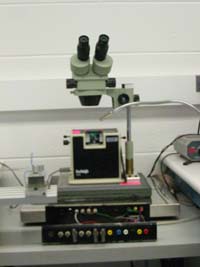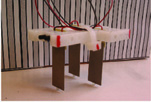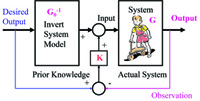|
|
Nanopositioning Applications
Summary:
Our research group was the first to demonstrate (experimentally)
that feedforward techniques can effectively compensate for
movement-induced vibrations to enable high-speed nanopositioning
in Scanning Probe Microscopes
(
Ref 2
and
Ref 3).
A review of control issues in nano-positioning can be found in
Ref 4
and a review on the use of feedforward control to
nanopositioning can be found in
Ref 5.
|
1. Nanopositioning for AFM and STM
This applied research has focused on the use of
inversion-based
approaches
to solve challenges in nano (and sub-nano) scale
precision positioning needed in scanning probe microscopes such as the
atomic force microscope (AFM) and the scanning
tunneling microscope (STM), e.g.,
see Ref 1.
It is noted that the AFM and STM are key enabling tools
in the nano area; therefore the current work aimed at
increasing their throughput will have a significant impact
on the real-time investigation and manipulation of nano-scale
and sub-nano-scale phenomena.
For example, the inability to precisely position an AFM probe
(at high speed) over a cell surface has traditionally
limited the ability to image time-varying dynamics of cellular processes.
In particular, lack of precision positioning
(due to movement-induced vibration) leads to
excessive forces on the cell surface (as the probe digs into the cell)
and causes sample damage.
Therefore, current AFM imaging of cells is limited to low operating speeds.
Our research group was the first to demonstrate (experimentally)
that feedforward techniques can effectively compensate for
movement-induced vibrations in Scanning Probe Microscopes
(
Ref 2
and
Ref 3).
Thereby, we showed that feedforward inputs could be used to increase
the operating speed of Scanning Probe Microscopes.
|
2. Biological Applications
Our current research aims to alleviate similar vibration-caused
positioning problems during high-speed imaging of soft biological samples.
The resulting high-speed AFM will enable the investigation of dynamic
cellular functions such as migration. Thus, the current research on
high-speed AFM imaging of human cells will have a significant impact on
future investigations of important issues in health and disease such
as the effects of aging on cell migration and the subsequent effect
on re-vascularization of ischemic tissue (for the treatment of heart disease).
|
3. Nanopositioning for High-Density Data Storage
High-density disk-drive storage systems
require nanometer scale positioning of the read/write head.
Algorithms for nano-precision, high-speed, positioning using
dual-stage systems were investigated under this research effort,
which was funded by the
Information Storage Industry
Consortium (INSIC),
which consists of companies such as Seagate,
Hitachi Global Storage, Samsung, and others.
A description of the research results can be found in
these presentation slides.
|
|
|
Contact Santosh Devasia:
devasia@u.washington.edu
|
|
|
|
Related Presentations
|



Nanopositioning: Theory and Application
|

Inversion-based Feedforward Theory (Conceptual Slides)
|

Application of Feedforward to Disk Drives:
Presentation to the Information Storage Industry Consortium
(INSIC)
|
References
Ref 1:
Q. Zou and S. Devasia
"Preview-based Optimal
Inversion for Output Tracking: Application to Scanning
Tunneling Microscopy,"
IEEE Transactions on Control Systems
Technology, Vol. 12(3), pp. 375-386, May 2004.
Ref 2:
D. Croft and S. Devasia
"Vibration Compensation for High Speed Scanning Tunneling Microscopy,"
Review of Scientific Instruments published by the American Institute of
Physics, Vol. 70 (12), pp. 4600-4605, December 1999.
Ref 3:
D. Croft, G. Shedd and S. Devasia
"Creep, Hysteresis, and Vibration Compensation for Piezoactuators:
Atomic Force Microscopy Application,"
ASME Journal of Dynamic Systems, Measurement and Control,
Vol. 123 (35), pp. 35-43, March 2001.
Ref 4:
S. Devasia, E. Eleftheriou and S. O. R. Moheimani
"A Survey of Control Issues in Nanopositioning,"
IEEE Transactions on Control Systems Technology, Vol. 15 (5),
pp. 802-823, September 2007, Special Issue on Dynamics and
Control of Micro- and Nanoscale Systems.
Ref 5:
G. M. Clayton, S. Tien, K. K. Leang, Q. Zou and S. Devasia
"A Review of Feedforward Control Approaches in Nanopositioning for
High Speed SPM,"
ASME Journal of Dynamic Systems, Measurement and
Control, Special Issue on Dynamic Modeling, Control and Manipulation
at the Nanoscale, Vol. 131 (6), Article number 061001, pp. 1-19, Nov. 2009
|
|






